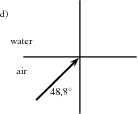| << Chapter < Page | Chapter >> Page > |
Complete the following ray diagrams to show the path of light in each situation.




The critical angle for water is .
We are asked to complete the diagrams.
For incident angles smaller than refraction will occur.
For incident angles greater than total internal reflection will occur.
For incident angles equal to refraction will occur at .
The light must travel from a high optical density to a lower one.

Refraction occurs (ray is bent away from the normal)

Total internal reflection occurs


Refraction towards the normal (air is less dense than water)
Total internal reflection is a powerful tool since it can be used to confine light. One of the most common applications of total internal reflection is in fibre optics . An optical fibre is a thin, transparent fibre, usually made of glass or plastic, for transmitting light. Optical fibres are usually thinner than a human hair! The construction of a single optical fibre is shown in [link] .
The basic functional structure of an optical fibre consists of an outer protective cladding and an inner core through which light pulses travel. The overall diameter of the fibre is about 125 m ( ) and that of the core is just about 50 m ( ). The mode of operation of the optical fibres, as mentioned above, depends on the phenomenon of total internal reflection. The difference in refractive index of the cladding and the core allows total internal reflection in the same way as happens at an air-water surface. If light is incident on a cable end with an angle of incidence greater than the critical angle then the light will remain trapped inside the glass strand. In this way, light travels very quickly down the length of the cable.

Optical fibres are most common in telecommunications, because information can be transported over long distances, with minimal loss of data. The minimised loss of data gives optical fibres an advantage over conventional cables.
Data is transmitted from one end of the fibre to another in the form of laser pulses. A single strand is capable of handling over 3000 simultaneous transmissions which is a huge improvement over the conventional co-axial cables. Multiple signal transmission is achieved by sending individual light pulses at slightly different angles. For example if one of the pulses makes a 72,23 angle of incidence then a separate pulse can be sent at an angle of 72,26 ! The transmitted data is received almost instantaneously at the other end of the cable since the information coded onto the laser travels at the speed of light! During transmission over long distances repeater stations are used to amplify the signal which has weakened somewhat by the time it reaches the station. The amplified signals are then relayed towards their destination and may encounter several other repeater stations on the way.
Optic fibres are used in medicine in endoscopes .

Notification Switch
Would you like to follow the 'Siyavula textbooks: grade 10 physical science' conversation and receive update notifications?